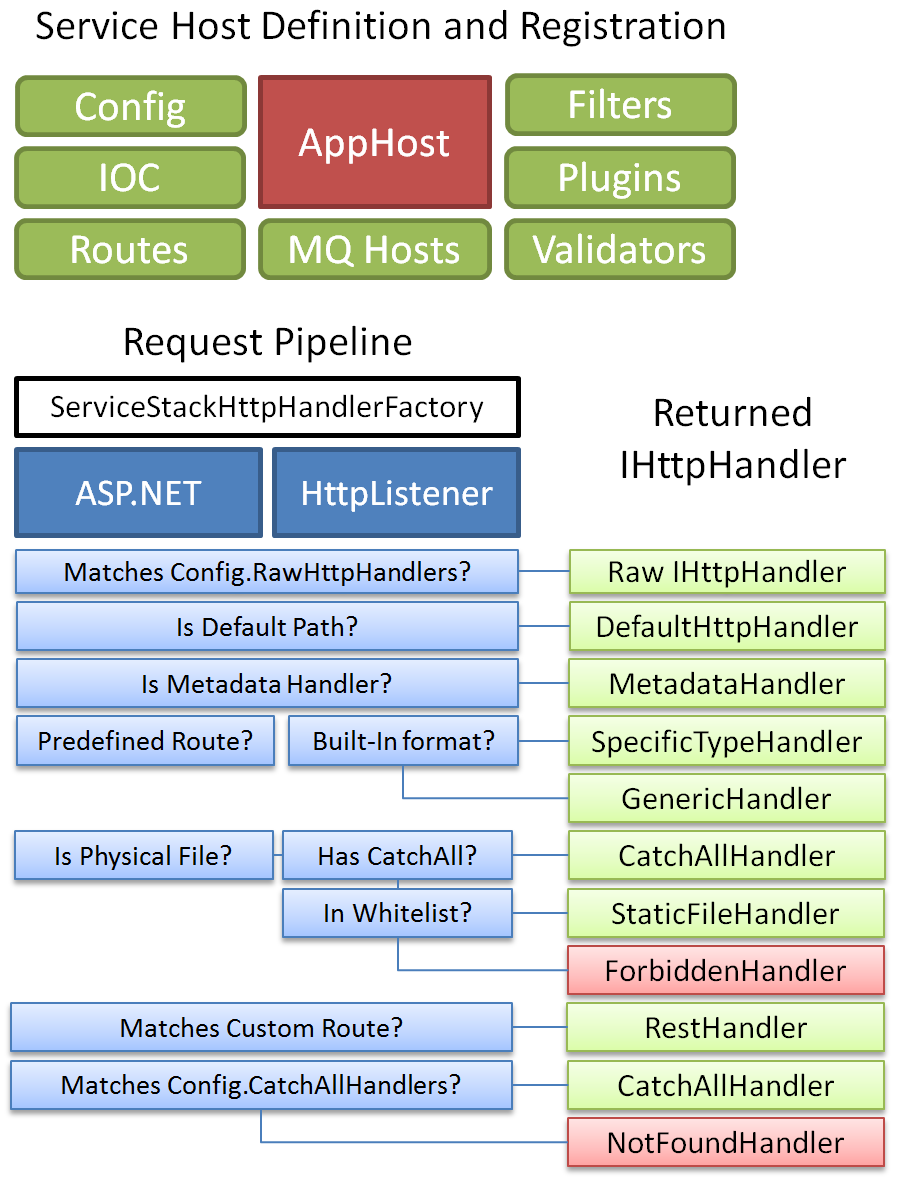HTTP Custom hooks
This list shows the order in which any user-defined custom hooks are executed.
The first set of filters is used to return the matching IHttpHandler for the request:
HostContext.RawHttpHandlersare executed before anything else, i.e. returning any ASP.NETIHttpHandlerby-passes ServiceStack completely and processes your customIHttpHandlerinstead.- Request is checked if matches any registered routes or static files and directories
- If the Request doesn't match it will search
IAppHost.CatchAllHandlersfor a match IAppHost.FallbackHandlersis the last handler executed for finding a handler to handle the request
Any unmatched requests will not be handled by ServiceStack and either returns a 404 NotFound Response in ASP.NET or HttpListener AppHosts or executes the next middleware in-line in .NET Core Apps.
Requests handled by ServiceStack execute the custom hooks and filters in the following order:
- The
IAppHost.PreRequestFiltersgets executed before the Request DTO is deserialized - Default Request DTO Binding or Custom Request Binding (if registered)
- Any Request Converters are executed
- Request Filter Attributes with Priority < 0 gets executed
- Then any Global Request Filters get executed
- Followed by Request Filter Attributes with Priority >= 0
- Action Request Filters
- Then your Service is executed with the configured Service Filters and Service Runner OnBeforeExecute, OnAfterExecute and HandleException custom hooks are fired
- Action Response Filters
- Any Response Converters are executed
- Followed by Response Filter Attributes with Priority < 0
- Then Global Response Filters
- Followed by Response Filter Attributes with Priority >= 0
- Finally at the end of the Request
IAppHost.OnEndRequestand anyIAppHost.OnEndRequestCallbacksare fired
Any time you close the Response in any of your filters, i.e. httpRes.EndRequest() the processing of the response is short-circuited and no further processing is done on that request.
Internal Service Gateway Requests
Internal Service Gateway Requests are executed using ServiceController.GatewayExecuteAsync API for invoking internal/trusted Services:
- Any
GatewayGlobal Request Filters get executed - Any Validation Filters
- Action Request Filters
- Then your Service is executed with the configured IServiceRunner and its OnBeforeExecute, OnAfterExecute and HandleException custom hooks are fired
- Action Response Filters
- Then
GatewayGlobal Response Filters
MQ (non-HTTP) Custom hooks
MQ Requests are executed using ServiceController.ExecuteMessage for invoking internal/trusted Services such as ServiceStack MQ:
- Any
MessageGlobal Request Filters get executed - Action Request Filters
- Then your Service is executed with the configured IServiceRunner and its OnBeforeExecute, OnAfterExecute and HandleException custom hooks are fired
- Action Response Filters
- Then
MessageGlobal Response Filters - Finally at the end of the Request
IAppHost.OnEndRequestis fired
RpcGateway
The RpcGateway provides a pure object model API for executing requests through the full HTTP Request pipeline including converting all Errors
inc. short-circuited Request Pipeline requests into an Error ResponseStatus that's populated into the Response DTO's ResponseStatus.
The RpcGateway is available via the single AppHost.RpcGateway API:
Task<TResponse> ExecuteAsync<TResponse>(object requestDto, IRequest req)
Unlike MQ Requests which uses ServiceController.ExecuteMessage to execute internal/trusted Services, the RpcGateway executes the full
HTTP Request Pipeline below:
- The
IAppHost.PreRequestFiltersgets executed before the Request DTO is deserialized - Any Request Converters are executed
- Request Filter Attributes with Priority < 0 gets executed
- Then any Global Request Filters get executed
- Followed by Request Filter Attributes with Priority >= 0
- Action Request Filters
- Then your Service is executed with the configured Service Filters and Service Runner OnBeforeExecute, OnAfterExecute and HandleException custom hooks are fired
- Action Response Filters
- Any Response Converters are executed
- Followed by Response Filter Attributes with Priority < 0
- Then Global Response Filters
- Followed by Response Filter Attributes with Priority >= 0
- Finally at the end of the Request
IAppHost.OnEndRequestand anyIAppHost.OnEndRequestCallbacksare fired
Where requests are executed through the same global Request/Response filters that normal HTTP ServiceStack Services execute making them suitable for executing external untrusted requests.
Implementation architecture diagram
The Implementation architecture diagram shows a visual cue of the internal order of operations that happens in ServiceStack:

After the IHttpHandler is returned, it gets executed with the current ASP.NET or HttpListener request wrapped in a common IHttpRequest instance.
The implementation of RestHandler shows what happens during a typical ServiceStack request:
